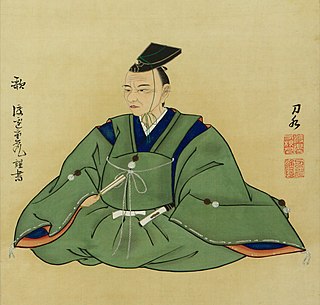Related Research Articles

Ōyama-tsumi or Ohoyama-tsumi, also Ōyama-tsumi-mi'oya-no-mikoto (大山祇御祖命), is a god of mountains, sea, and war in Japanese mythology. He is an elder brother of Amaterasu and Susanoo. His other names are Watashi-no-Ōkami (和多志大神) and Sakatoke (酒解神).

Shide are zigzag-shaped paper streamers, often seen attached to shimenawa or tamagushi to demarcate holy spaces, and used in Shinto rituals in Japan. They are usually found adorning doorways, shrine buildings, and kamidana.

A mitamaya is an altar used in Shinto-style ancestor worship, dedicated in the memory of deceased forebears. It generally has a mirror symbolizing the spirits of the deceased or a tablet bearing their names and is used not only to enshrine blood relatives, but also to honor respected non-family members.
Toshigami, also known as Ōtoshi-no-kami, is a Japanese kami and a part of the Shinto pantheon.

The Association of Shinto Shrines is a religious administrative organisation that oversees about 80,000 Shinto shrines in Japan. These shrines take the Ise Grand Shrine as the foundation of their belief. It is the largest Shrine Shinto organization in existence.
The Engishiki is a Japanese book about laws and customs. The major part of the writing was completed in 927.
Ubusunagami in Shinto are tutelary kami of one's birthplace.
Takamimusubi is a god of agriculture in Japanese mythology, who was the second of the first beings to come into existence.
Kukunochi is the kami of trees, the kami is also called Ki-no-kami, or Kuku-no-shi. He is the brother of Ōyamatsumi, Shimatsuhiko, and Watatsumi.
Kamimusubi (神産巣日), also known as Kamimusuhi among other variants, is a kami and god of creation in Japanese mythology. They are a hitorigami, and the third of the first three kami to come into existence (Kotoamatsukami), alongside Ame-no-Minakanushi and Takamimusubi, forming a trio at the beginning of all creation. The name is composed of kami, denoting deity, and musubi, meaning "effecting force of creation".
Wakumusubi (和久産巣日神) is a kami of agriculture. In many versions, he was born from the urine of Izanami when she died. Another version of the Nihon Shoki states he was a child of Kagutsuchi and Haniyasu-hime.

Mizuhanome is a God in Japanese mythology. She is a kami of water. She was born from the urine of Izanami.
Sect Shinto refers to several independent organized Shinto groups that were excluded by law in 1882 from government-run State Shinto. These independent groups have more developed belief systems than mainstream Shrine Shinto, which focuses more on rituals. Many such groups are organized into the Kyōha Shintō Rengōkai. Before World War II, Sect Shinto consisted of 13 denominations, which were referred to as the 13 Shinto schools. Since then, there have been additions and withdrawals of membership.
The National Association of Shinto Priests was a Japanese religious association that promoted the prosperity of Shinto shrines and the improvement and development of Kannushi. It was founded in 1898 to expound the Kokutai ideology. It was dissolved in 1946 with the formation of the religious corporation, which became one of the predecessor organizations of the Association of Shinto Shrines.
The Institute of Divinities is one of the former state agencies of Japan. Ministry of the Interior's foreign bureau. Its purpose was to increase the prestige of Shintoism among the people and it was the core of shrine administration and Shintoism until the end of WWII.

Fukko Shintō is a movement within Shinto that was advocated by Japanese scholars during the Edo period. It attempted to reject Buddhist and Confucian influence on Shinto and return to a native Japanese tradition based on Koshinto.
The Great Teaching Institute was an organization under the Ministry of Religion in the Empire of Japan.

Hakushu 拍手 (神道) is a word used to refer to ceremonial clapping in Shinto. It is also known as Kashiwade.

Confucian Shinto, also known as Juka Shintō (儒家神道) in Japanese, is a syncretic religious tradition that combines elements of Confucianism and Shinto. It originated in Japan during the Edo period (1603-1868), and is sometimes referred to as "Neo-Confucian Shinto"
Ame-no-Fuyukinu is the son of Omizunu and Futemimi, the husband of Sashikuni Wakahime and the father of Ōkuninushi(Ōnamuchi).
References
- ↑ https://archive.today/uJNu5
- ↑ "Encyclopedia of Shinto詳細". 國學院大學デジタルミュージアム (in Japanese). Retrieved 10 March 2023.
- 1 2 3 "Encyclopedia of Shinto詳細". 國學院大學デジタルミュージアム (in Japanese). Retrieved 6 March 2023.
- ↑ Cali, Joseph; Dougill, John (30 November 2012). Shinto Shrines: A Guide to the Sacred Sites of Japan's Ancient Religion. University of Hawaii Press. ISBN 978-0-8248-3775-4.
- ↑ Makoto, Hayashi; Luers, Dylan; 林淳 (2013). "The Development of Early Modern Onmyōdō". Japanese Journal of Religious Studies. 40 (1): 151–167. ISSN 0304-1042.
- ↑ "天社土御門神道本庁". JAPANESE RELIGIONS (in Japanese). 5 October 2015. Retrieved 6 March 2023.
- ↑ "備忘録 天社土御門神道 本庁". kashomemorandum.blog.fc2.com. Retrieved 6 March 2023.